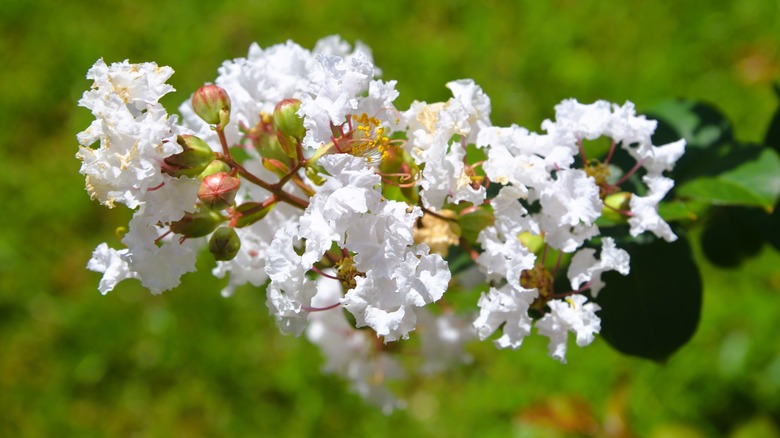Hardy in USDA zones 6 through 9, crepe myrtles (plants in the Lagerstroemia genus) are a beloved part of many southern summer gardens. Their colorful flowers and distinctive bark make these plants, which can be grown as small trees or large shrubs, obvious choices for landscapes or as specimen trees. However, errors in pruning timing or technique can easily mar your crape myrtle’s beauty, make it flower less, or even put it at risk for disease. By pruning your trees the right way during late winter or early spring, you’ll be able to enjoy stunning flowers throughout spring. You also want to ensure that you don’t over prune the plant, a common mistake many home gardeners make.
There are good reasons why crepe myrtles are such popular plants. These trees come in a variety of cultivars with heights ranging from 10 feet to 30 feet. Their flowers come in colors ranging from the traditional reds and pinks to whites and purples. This means there’s a crepe myrtle for almost every taste and space. As long as these plants are placed in full sun and have well-draining soil, they’re likely to perform well — but pruning correctly and at the right time is also extremely important.
When to prune crepe myrtles

Crepe myrtles bloom on new wood, which means that their flowers form on branches that grew earlier in the same year. As with most trees that bloom on new wood, the best time to prune crepe myrtles is in late winter or very early spring, before they break dormancy. If you prune your crepe myrtle in February or March instead of in the autumn, you’ll not only have a more natural-looking and elegant tree through the winter months, but you can also take any winter damage into account when pruning. Pruning also tends to stimulate growth, which is the last thing you want in late autumn. This is when the plant should be working on winding down for the season instead of creating new branches that may be too fragile to survive through the winter.
While you don’t have to trim crepe myrtles during the summer, many people remove spent blooms and the tips of branches to encourage further flowering. This can be helpful on older varieties but isn’t necessary on newer cultivars that are bred to be repeat bloomers with no pruning necessary. Always avoid heavy summer pruning unless there are damaged or diseased branches that need to be removed.
Avoid over pruning crepe myrtles
As important as it is to prune crepe myrtles at the right time of year, it’s also essential to use the correct techniques. Institutions including The University of Florida and Clemson Cooperative Extension have pleaded with gardeners to stop engaging in so-called “crape murder” — that is, aggressively over pruning their crepe myrtles. While it is a common belief that topping crepe myrtle, or cutting off a significant amount of the tops of the branches every year, can encourage more flowers, it actually weakens the tree and puts it at risk for common crepe myrtle diseases and pests.
Instead of topping your crepe myrtle, when pruning, encourage the tree’s natural vase shape and focus primarily on removing branches that cross or grow into the middle of the tree instead of outwards. Also focus on encouraging good airflow through the tree, which can help decrease fungal issues. Crepe myrtles often don’t require heavy pruning, so don’t feel obligated to trim at all if the tree already looks good.